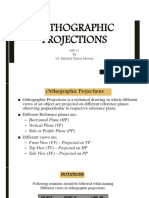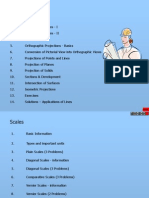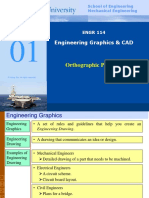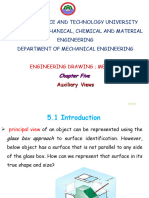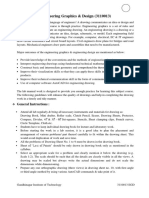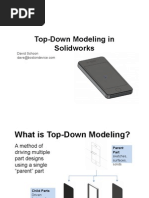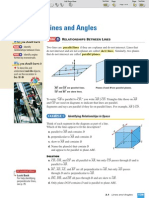Notes For Projection of Points and Lines
Uploaded by
Shantam SinhaNotes For Projection of Points and Lines
Uploaded by
Shantam SinhaSymbiosis Institute of Technology, Pune.
Chapter 2
Projection Of Lines
The majority of engineering drawings made by orthographic projections.
An object is represented by boundaries of all surfaces of the object. The
boundary of surface may be made up of straight lines or curves or both. As
such lines and curves made up of number of points, is logically started with
projection of points.
Figure 1 Plane of projection
Projection of points
Figure 2 Quadrant System
Based on the quadrant system shown in figure 2,the space is divided in
to four parts. The point in the different quadrants are defined as,
Engineering Graphics
Page 1
Symbiosis Institute of Technology, Pune.
Quadrant
First
Second
Third
Forth
Location
In front of Vp, above HP
Behind VP ,above HP
Behind VP, below HP
In front of VP , below HP
Position of points:
(i) In front of the VP and above the HP
(ii) In front of the VP and in the HP
(iii) In the VP and above the HP
(iv) Behind the VP and above the HP
(v) Behind the VP and in the HP
(vi) Behind the VP and below the HP
(vii) In the VP and below the HP
(viii) In front of the VP and below the HP
(ix) In the VP and HP
Figure 3Conversion of point in 3D to 2D
Engineering Graphics
Page 2
Symbiosis Institute of Technology, Pune.
GENERAL PROCEDURE TO DRAW PROJECTION OF POINTS
1. From given data identify the quadrant
2. Draw the XY line and projection
3. Along this projector mark by dots the distances of the given point form the
HP and VP, on the corresponding side of the XY line, depending upon the
quadrant in which the point lies, to locate the front view and the top view,
respectively.
4. Make the front view and the top view bold and rub off the unwanted length
of the projector to complete the solution.
A straight line is the shortest distance between two points.
Projections of the ends of any line can be drawn using the principles developed
for projections of points. Top views of the two end points of a line, when
joined, give the top view of the line. Front views of the two end points of the
line, when joined, give the front view of the line. Both these Projections are
straight lines.
Engineering Graphics
Page 3
Symbiosis Institute of Technology, Pune.
Engineering Graphics
Page 4
Symbiosis Institute of Technology, Pune.
Engineering Graphics
Page 5
Symbiosis Institute of Technology, Pune.
To Find True length and true inclinations of a line
Given : The top and front views of a line are given
The top and front views of the object can be drawn from the following
data: (a) Distance between the end projectors, (b) Distance of one or both the
Engineering Graphics
Page 6
Symbiosis Institute of Technology, Pune.
end points from HP and VP and (c) Apparent inclination.
Step by Step Procedure
1. Top and front views Draw the top view ab and the front view a'b' as given
2. Rotation of the top view
With center a and radius ab rotate the top view to the new position
ab1 to make it parallel to the XY line. Since ab1 is parallel to the XY line, its
corresponding front view will be in true length and at true inclination.
Engineering Graphics
Page 7
Symbiosis Institute of Technology, Pune.
3. Rotation of the front view Similarly, with center a' and radius a'b'
rotate the front view to the new position a'b2' parallel to the XY line. Since
a'b2' is parallel to the XY line, its corresponding top view will be in true length
and at true inclination.
In this position, the line will be parallel to HP and inclined at f to VP.
Through b draw the locus of B in the top view. Project b2' to get b2, in
the top view. Connect ab2 which will be in true length and true inclination
which the given line AB makes with VP.
Projections of lines (Drawing practice)
Problem -1
A straight line AB of true length 100 mm has its end A 20 mm above HP and 30
mm in front of VP. The top view of the line is 80 mm and front view is 70 mm.
Draw the projections (TV and FV) of the line AB and obtain the true inclinations
of the line AB with HP and VP.
Solution: The solution to the problem is shown in figure . The step wise
procedure for the solution is discussed below:
Engineering Graphics
Page 8
Symbiosis Institute of Technology, Pune.
Draw XY line and mark points a (20 mm above XY line ) and a (30mm below XY line)
as given in the question.
Let us assume that the line is parallel to HP and Inclined to VP.
Draw a horizontal line from a and mark distance equal to 70 mm on it. The end
point is b2. i.e., a b2 = 70 mm.
In this condition, the FV is parallel to XY line. TV can be obtained considering the
following points:
TV of point B will be along the vertical projector drawn from B2.
TV of line AB will be the true length = 100mm .
The true inclination of the line with VP can also be obtained.
Draw a projector downwards from b2. It is clear that if TL of AB is drawn from a with
the required inclination with the VP, it will give the distance a b2. Therefore, with
radius equal to TL= 100mm and with centre a, cut an arc on the downward projector
from b2. Let this be ab2. Inclination of ab2 with horizontal will give true inclination
of line AB with VP.
Locus of point B is marked as a horizontal line at b2.
Engineering Graphics
Page 9
Symbiosis Institute of Technology, Pune.
Let us no assume that the line is parallel to VP and inclined to HP.
In this condition, the TV is parallel to XY line. FV can be obtained considering the
following points:
FV of point B will be along the vertical projector drawn from B2.
FV of line AB will be the true length = 100mm .
The true inclination of the line with HP can also be obtained.
Draw a horizontal line from a and mark distance equal to 80 mm on it. The end point
is b1. a b1 = 80 mm.
Draw a projector upwards from b1. It is clear that if TL of AB is drawn from a with
the required inclination with the HP, it will give the distance ab1. Therefore, with
radius equal to TL= 100mm and with centre a, cut an arc on the upward projector
from b1. Let this be ab1. Inclination of ab1 with horizontal will give true inclination
of line AB with HP.
Locus of point B is marked as a horizontal line at b1. (1)
Drawing the top view and front view of line AB
The plan of AB (ab) is obtained as follows: With a as centre and radius equal to ab1,
cut an arc on the locus line drawn at b2.
The elevation of AB (ab) is obtained as follows: With a as centre and radius equal
to ab2, cut an arc on the locus line drawn at b1.
Traces of a line The trace of a line is defined as a point at which the given line, if
produced, meets or intersects a plane.
When a line meets HP, (or if necessary on the extended portion-of HP),
the point at which the line meets or intersects the horizontal plane, is called
horizontal trace (HT)of the line and denoted by the letter H.
When a line meets VP (or if necessary on the extended portion of VP),
the point at which the line meets or intersects the vertical plane, is called
vertical trace (VT) of the line and denoted by the letter V.
Trace of a line perpendicular to one plane and parallel to the otherSince the line is perpendicular to one plane and parallel to the other, the
trace of the line is obtained only on the plane to which it is perpendicular, and
no trace of the line is obtained on the other plane to which it is parallel.
Engineering Graphics
Page 10
Symbiosis Institute of Technology, Pune.
Traces of a line inclined to one plane and parallel to the otherWhen the line is inclined to one plane and parallel to the other, the trace
of the line is obtained only on the plane to which it is inclined, and no trace is
obtained on the plane to which it is parallel.
Engineering Graphics
Page 11
Symbiosis Institute of Technology, Pune.
Traces of line inclined to both planes
Engineering Graphics
Page 12
Symbiosis Institute of Technology, Pune.
****Important points for projections of lines1. True length of the line is seen only when the line is parallel to either of the
reference plane and it always makes true angle with the other plane.
e.g., Theta [] is true angle of the line with H.P. and phi [] is true angle with
V.P.
2. When true length is seen in one view , its apparent length must be parallel to
XY line and seen in another view.
3. Angle made by the line with H.P. is always seen in F.V. [,] and angle made
by the line with V.P. is always seen in T.V. [,].
4. Oblique line is seen as appeared / apparent length in both the views.
FVL [Front View Line] is inclined at an angle in F.V.
TVL [Top View Line] is inclined at an angle in T.V.
5. While obtaining projections of an oblique line, always start from simple line
end of apparent line and move along a circular arc. End of the true length
always move along a straight line path.
Engineering Graphics
Page 13
Symbiosis Institute of Technology, Pune.
6. To obtain H.T. extend FVL till it meets XY line (h). Draw projection through
this point until it meets extended TVL (h). This point will be called as HT.
7. To obtain V.T. extend TVL till it meets XY line (v). Draw projection through this
point until it meets extended FVL (v). This point will be called as VT.
8. FV of HT will be h and TV of VT will be v. h and v will always lies on XY line.
9. a, b, h, v should always lie on the same line i.e., FVL either extended or
inside the line.
10. a, b, h, v should always lie on the same line i.e., TVL either extended or inside
the line.
Engineering Graphics
Page 14
You might also like
- Instrument Drawing and Lettering TechniquesNo ratings yetInstrument Drawing and Lettering Techniques15 pages
- Engineering Graphics: Projection Theory (Part: Two)No ratings yetEngineering Graphics: Projection Theory (Part: Two)32 pages
- 2 Marks Previous Board Exam Questions & AnswersNo ratings yet2 Marks Previous Board Exam Questions & Answers7 pages
- Free Hand Sketching - Free Hand Drawing Lecture NotesNo ratings yetFree Hand Sketching - Free Hand Drawing Lecture Notes14 pages
- First and Third Angle in Engineering Drawing100% (5)First and Third Angle in Engineering Drawing20 pages
- Drawing Supplement: University of Wisconsin-MilwaukeeNo ratings yetDrawing Supplement: University of Wisconsin-Milwaukee76 pages
- Sample Multiple Choice Questions (MCQ) : Unit - I100% (1)Sample Multiple Choice Questions (MCQ) : Unit - I22 pages
- Advantages of CAD Over Conventional Drawing Techniques (Assignnet 1)100% (1)Advantages of CAD Over Conventional Drawing Techniques (Assignnet 1)9 pages
- Orthographic Projection: Engineering Graphics & CAD100% (1)Orthographic Projection: Engineering Graphics & CAD84 pages
- Sectional Views - Engineering - DrawingNo ratings yetSectional Views - Engineering - Drawing24 pages
- EGD - 3110013 - Lab - Manual - EVEN - 2023 - 24No ratings yetEGD - 3110013 - Lab - Manual - EVEN - 2023 - 2457 pages
- Introduction To Engineering Drawing & Projection of PointsNo ratings yetIntroduction To Engineering Drawing & Projection of Points27 pages
- Class 1 - Introduction To Industrial DrawingNo ratings yetClass 1 - Introduction To Industrial Drawing41 pages
- Lecture 6 - Projection of Lines Inclined To HP and VP and Traces - Students PDFNo ratings yetLecture 6 - Projection of Lines Inclined To HP and VP and Traces - Students PDF55 pages
- Projections of Points and Straight Lines - IINo ratings yetProjections of Points and Straight Lines - II28 pages
- 1.9.4 Test (TST) - Foundations of Geometry (Test)No ratings yet1.9.4 Test (TST) - Foundations of Geometry (Test)11 pages
- Mathematics: Quarter 3 - Module 2: AnglesNo ratings yetMathematics: Quarter 3 - Module 2: Angles23 pages
- Euclid 5th Postulate's Verification by Al-HaythamNo ratings yetEuclid 5th Postulate's Verification by Al-Haytham11 pages
- Engineering - Drawing 13ME101 Syllabus 2 CreditsNo ratings yetEngineering - Drawing 13ME101 Syllabus 2 Credits2 pages
- Ncert Exemplar Jan2021 Class 6 Maths Solutions Chapter 2No ratings yetNcert Exemplar Jan2021 Class 6 Maths Solutions Chapter 216 pages
- For Demo A Detailed Lesson Plan in Grade 7 MathematicsNo ratings yetFor Demo A Detailed Lesson Plan in Grade 7 Mathematics9 pages
- Lobatchewsky, The Origins of Non-Euclidean Geometries100% (1)Lobatchewsky, The Origins of Non-Euclidean Geometries16 pages
- 5.5 Parallel and Perpendicular Lines: The Dark Doodad NebulaNo ratings yet5.5 Parallel and Perpendicular Lines: The Dark Doodad Nebula19 pages
- Engineering Graphics: Projection Theory (Part: Two)Engineering Graphics: Projection Theory (Part: Two)
- Free Hand Sketching - Free Hand Drawing Lecture NotesFree Hand Sketching - Free Hand Drawing Lecture Notes
- Drawing Supplement: University of Wisconsin-MilwaukeeDrawing Supplement: University of Wisconsin-Milwaukee
- Advantages of CAD Over Conventional Drawing Techniques (Assignnet 1)Advantages of CAD Over Conventional Drawing Techniques (Assignnet 1)
- Orthographic Projection: Engineering Graphics & CADOrthographic Projection: Engineering Graphics & CAD
- Introduction To Engineering Drawing & Projection of PointsIntroduction To Engineering Drawing & Projection of Points
- Lecture 6 - Projection of Lines Inclined To HP and VP and Traces - Students PDFLecture 6 - Projection of Lines Inclined To HP and VP and Traces - Students PDF
- Ncert Exemplar Jan2021 Class 6 Maths Solutions Chapter 2Ncert Exemplar Jan2021 Class 6 Maths Solutions Chapter 2
- For Demo A Detailed Lesson Plan in Grade 7 MathematicsFor Demo A Detailed Lesson Plan in Grade 7 Mathematics
- Lobatchewsky, The Origins of Non-Euclidean GeometriesLobatchewsky, The Origins of Non-Euclidean Geometries
- 5.5 Parallel and Perpendicular Lines: The Dark Doodad Nebula5.5 Parallel and Perpendicular Lines: The Dark Doodad Nebula





